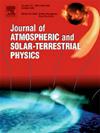Seasonal asymmetries in the lag between insolation and surface air temperature over Iran during 1971–2017
IF 1.8
4区 地球科学
Q3 GEOCHEMISTRY & GEOPHYSICS
Journal of Atmospheric and Solar-Terrestrial Physics
Pub Date : 2025-01-18
DOI:10.1016/j.jastp.2025.106441
引用次数: 0
Abstract
The seasonal cycle in surface air temperature reflects the systematic variation in incoming solar radiation during a year. The current study focused on spatiotemporal analysis of the seasonal asymmetries in the lag between insolation and surface air temperature over Iran and the long-term trend over Iran. To do this, daily gridded surface air temperature data with spatial resolution of 0.25° × 0.25° over Iran during period 1971–2017 has been used. The results demonstrated that the seasonal cycle of surface air temperature did not coincide on annual harmonic. The time lag of maximum surface air temperature between insolation forcing and maximum surface air temperature response varies from 1 to 48 days across Iran. Maximum surface air temperature shows short lags over southeastern regions and long lags over western and northwestern regions. The time lag of minimum surface air temperature relative to winter solstice is less variable than maximum surface air temperature and differs from 26 to 48 days across Iran. The seasonal asymmetries (ASYM) which defined as the time lag of maximum surface air temperature relative to summer solstice minus the time lag of minimum surface air temperature relative to winter solstice generally showed positive values over the northwestern and western regions, indicating prolonged spring. Negative values over the southeastern, eastern and southwestern coastal regions of the Caspian Sea in the north, showing that the winter minimum surface air temperature is delayed more than the summer maximum surface air temperature. Most areas over the country have encountered negative trends in the time lag of minimum surface air temperature. These results suggest that changes in seasonal surface air temperature lags can be a potential predictor of shifting in climatic parameters at a seasonal time scale.
1971-2017年伊朗日照与地表气温滞后的季节不对称性
地表气温的季节循环反映了一年中入射太阳辐射的系统变化。本研究重点分析了伊朗地区日晒和地表气温滞后的季节不对称性及其长期趋势。为此,使用了1971-2017年期间伊朗地区空间分辨率为0.25°× 0.25°的逐日网格化地表气温数据。结果表明,地表气温的季节周期与年调和不重合。在伊朗,最高地表气温在日照强迫和最高地表气温响应之间的时间差从1天到48天不等。地表最高气温在东南地区滞后较短,在西部和西北部滞后较长。最低地表气温相对于冬至的滞后时间变化比最高地表气温的滞后时间变化小,在伊朗各地从26天到48天不等。季节不对称(ASYM)(最高地表气温相对于夏至的时间差减去最低地表气温相对于冬至的时间差)在西北和西部地区普遍为正值,表明春季延长。北部里海东南、东部和西南沿海地区为负值,表明冬季最低地面气温比夏季最高地面气温延迟更多。全国大部分地区在最低地表气温的时间滞后上都出现了负趋势。这些结果表明,季节性地表气温滞后的变化可能是季节性时间尺度上气候参数变化的潜在预测因子。
本文章由计算机程序翻译,如有差异,请以英文原文为准。
求助全文
约1分钟内获得全文
求助全文
来源期刊

Journal of Atmospheric and Solar-Terrestrial Physics
地学-地球化学与地球物理
CiteScore
4.10
自引率
5.30%
发文量
95
审稿时长
6 months
期刊介绍:
The Journal of Atmospheric and Solar-Terrestrial Physics (JASTP) is an international journal concerned with the inter-disciplinary science of the Earth''s atmospheric and space environment, especially the highly varied and highly variable physical phenomena that occur in this natural laboratory and the processes that couple them.
The journal covers the physical processes operating in the troposphere, stratosphere, mesosphere, thermosphere, ionosphere, magnetosphere, the Sun, interplanetary medium, and heliosphere. Phenomena occurring in other "spheres", solar influences on climate, and supporting laboratory measurements are also considered. The journal deals especially with the coupling between the different regions.
Solar flares, coronal mass ejections, and other energetic events on the Sun create interesting and important perturbations in the near-Earth space environment. The physics of such "space weather" is central to the Journal of Atmospheric and Solar-Terrestrial Physics and the journal welcomes papers that lead in the direction of a predictive understanding of the coupled system. Regarding the upper atmosphere, the subjects of aeronomy, geomagnetism and geoelectricity, auroral phenomena, radio wave propagation, and plasma instabilities, are examples within the broad field of solar-terrestrial physics which emphasise the energy exchange between the solar wind, the magnetospheric and ionospheric plasmas, and the neutral gas. In the lower atmosphere, topics covered range from mesoscale to global scale dynamics, to atmospheric electricity, lightning and its effects, and to anthropogenic changes.
 求助内容:
求助内容: 应助结果提醒方式:
应助结果提醒方式:


